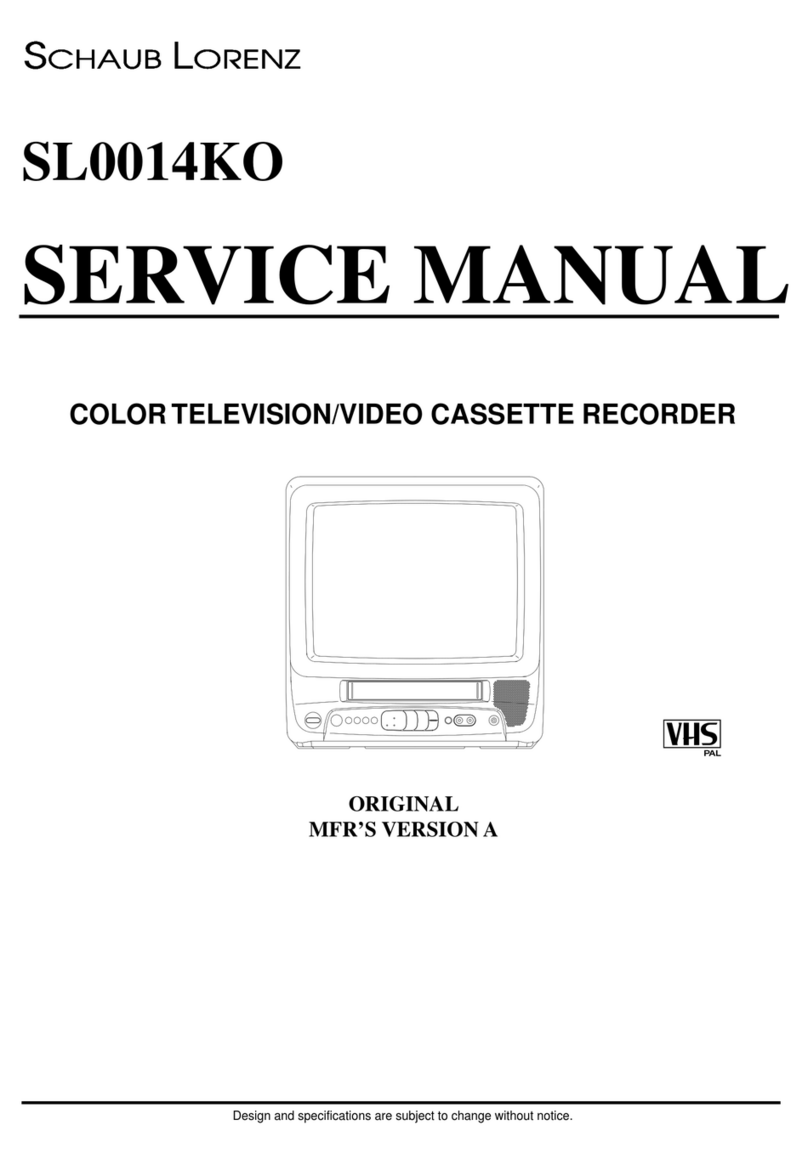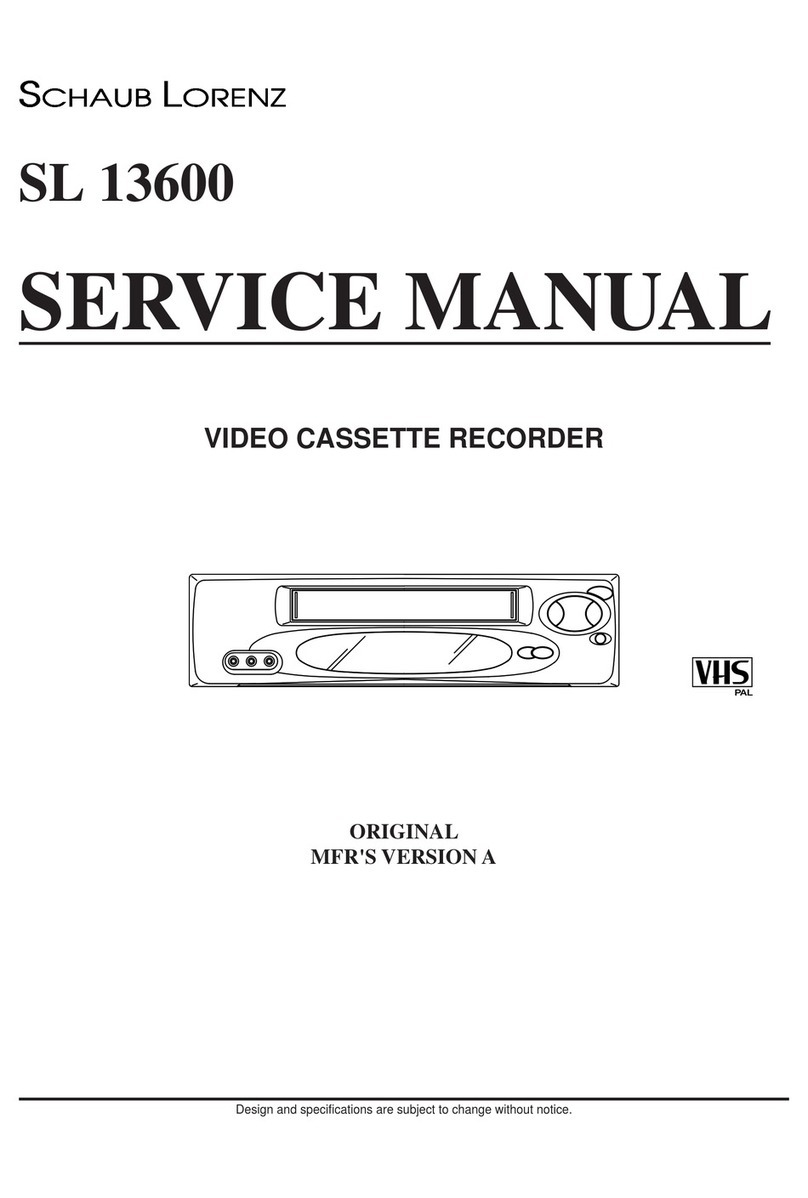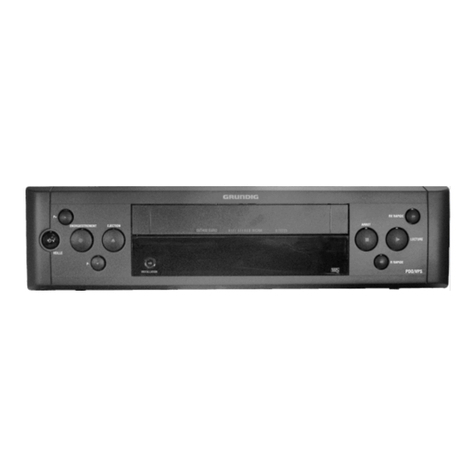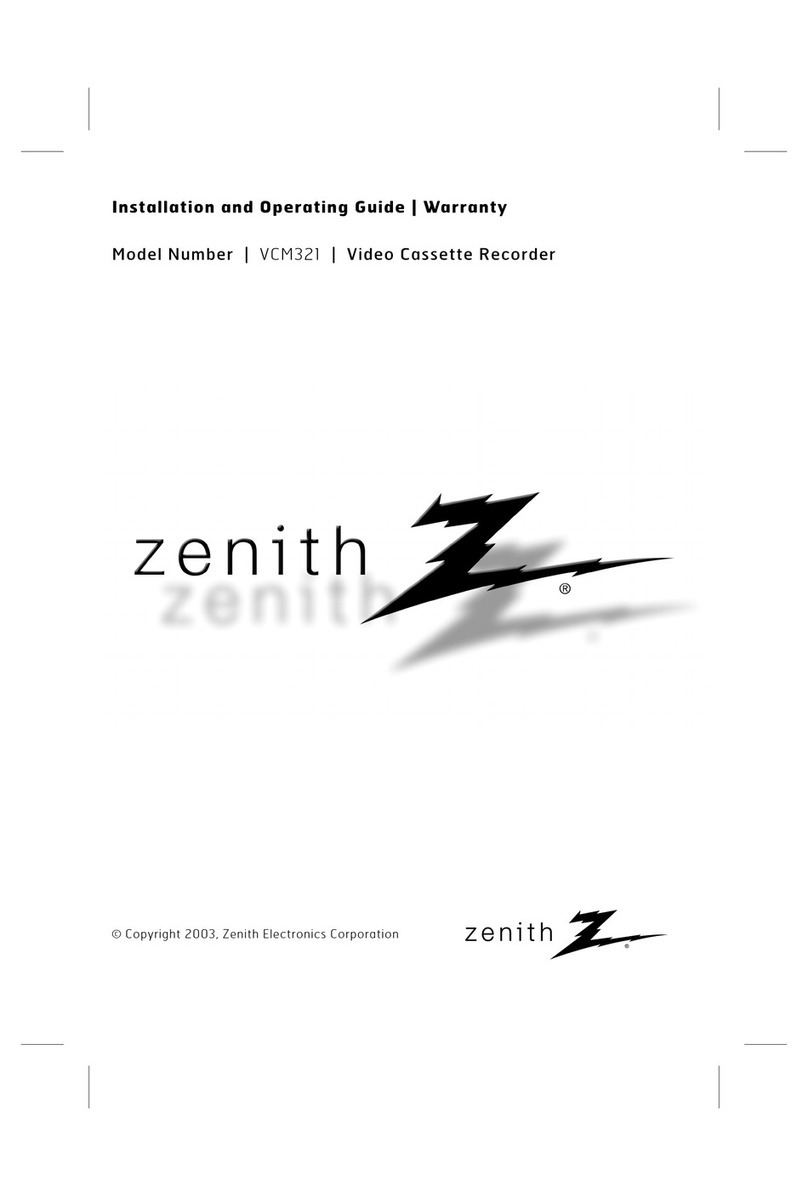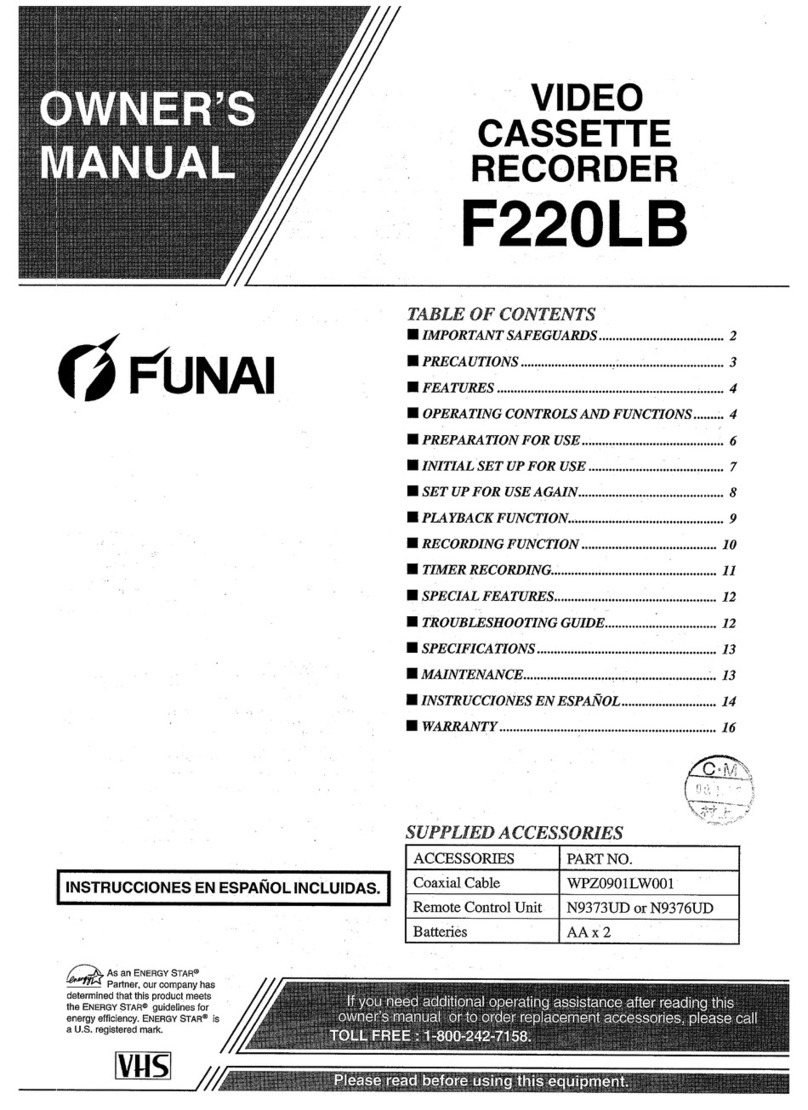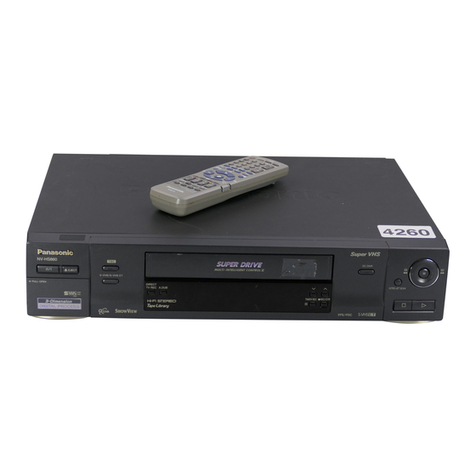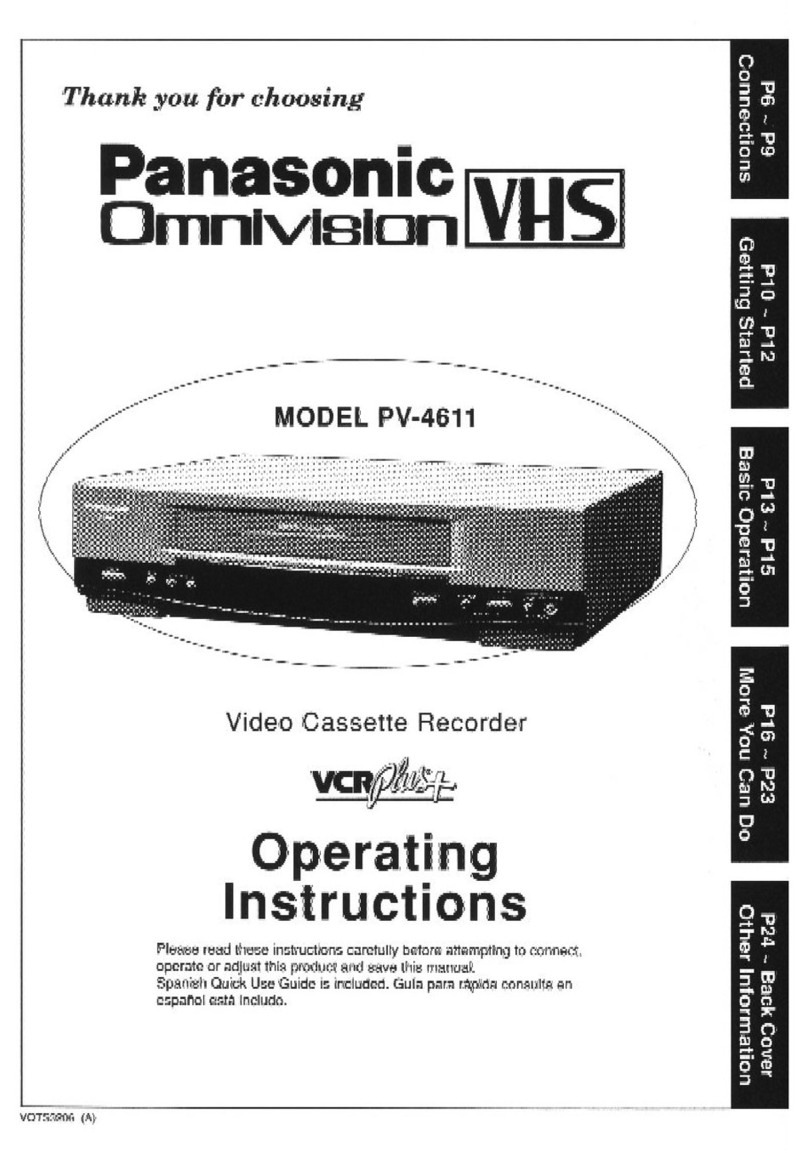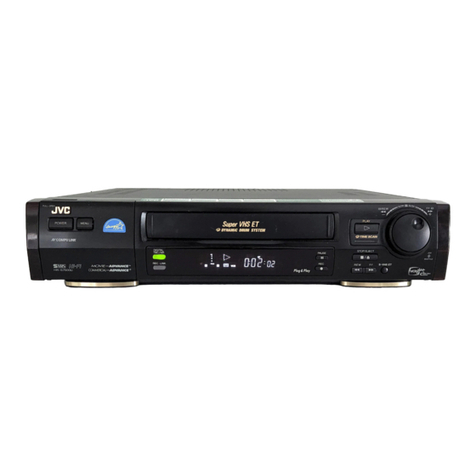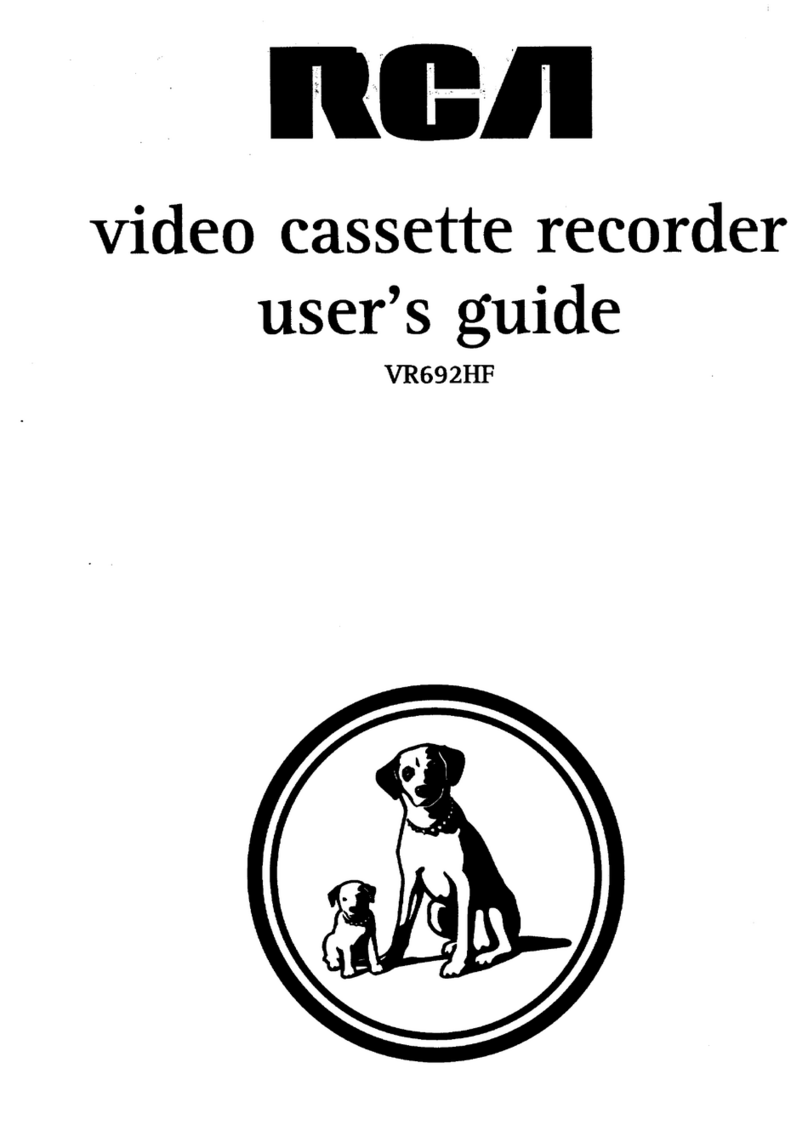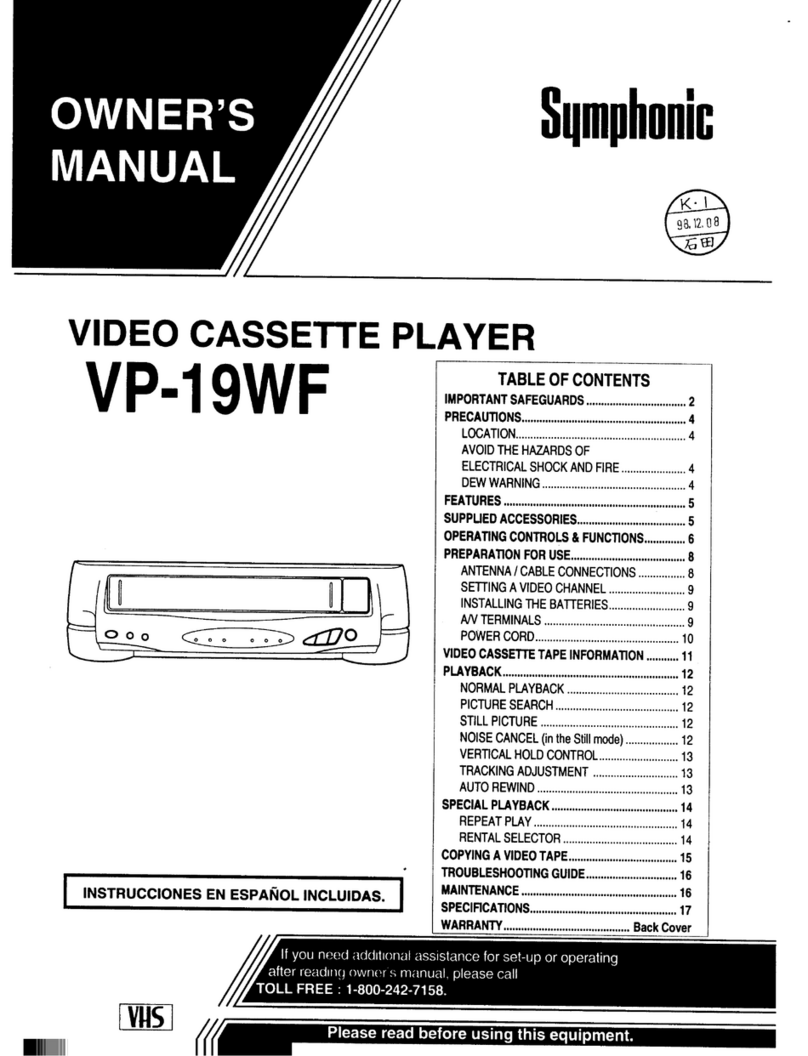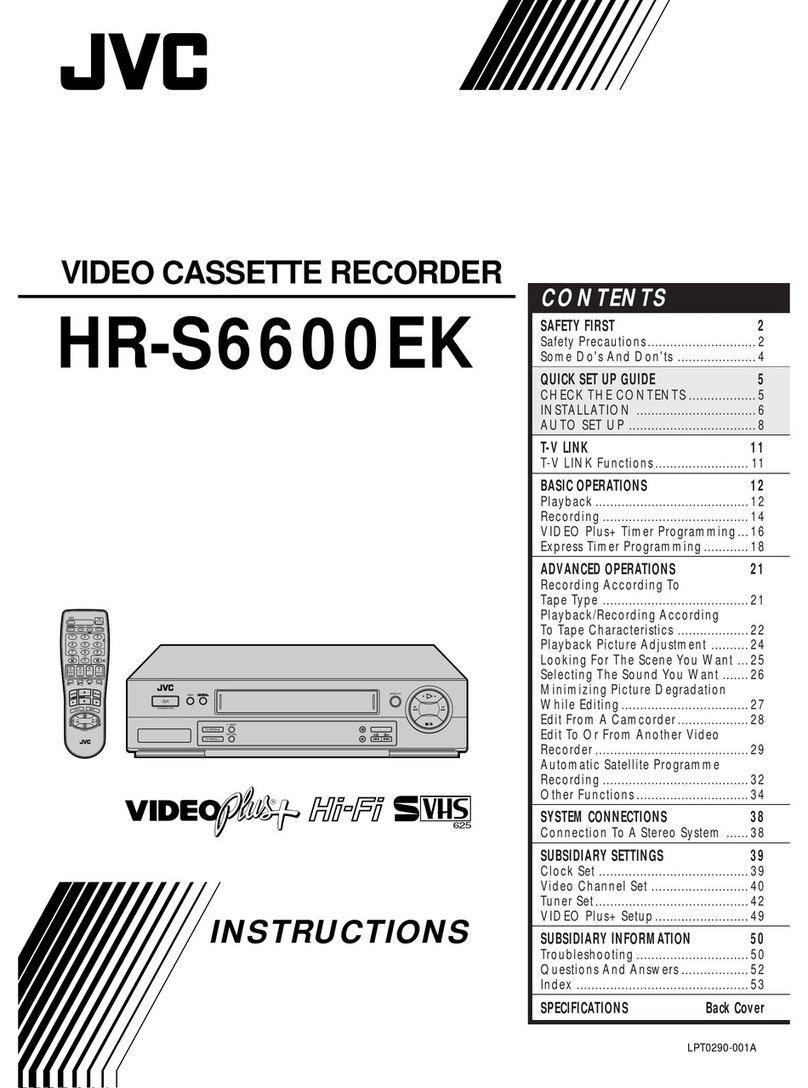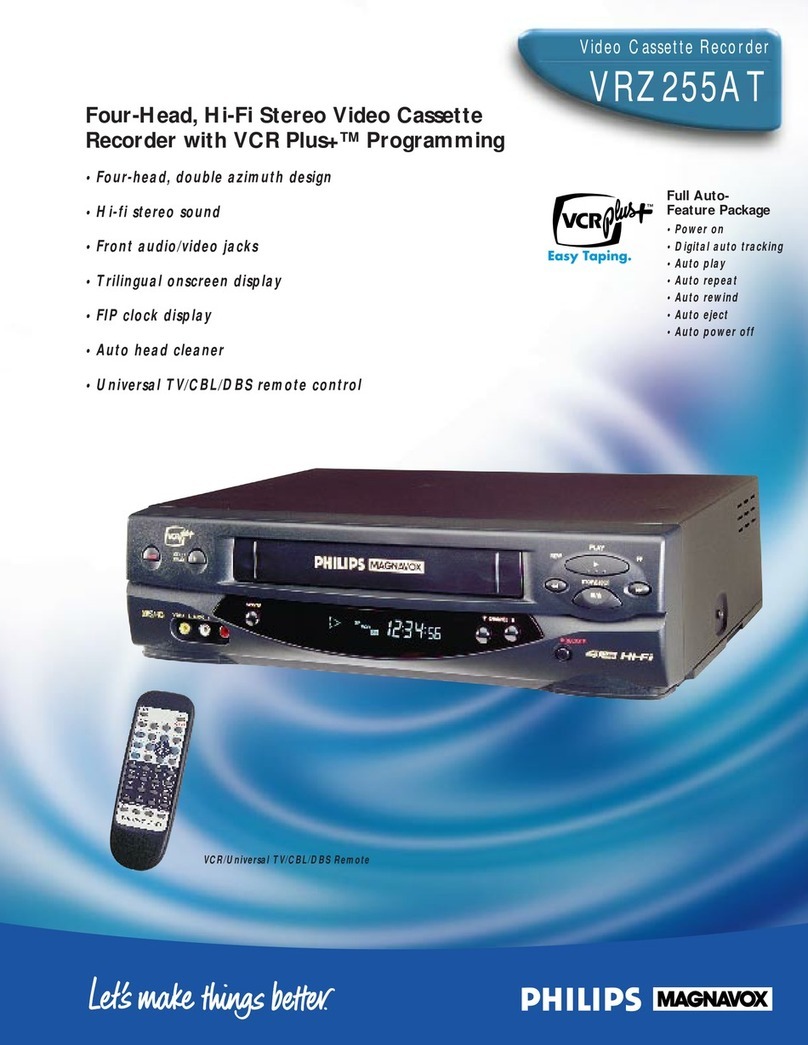Schaub Lorenz SL0520KO User manual

SERVICE MANUAL
SL0520KO
Design and specifications are subject to change without notice.
COLOR TELEVISION/VIDEO CASSETTE RECORDER
ORIGINAL
MFR’S VERSION B

SERVICING NOTICES ON CHECKING
6. AVOID AN X-RAY1. KEEP THE NOTICES
As for the places which need special attentions,
they are indicated with the labels or seals on the
cabinet, chassis and parts. Make sure to keep the
indications and notices in the operation manual.
3. USE THE DESIGNATED PARTS
5. TAKE CARE TO DEAL WITH THE
CATHODE-RAY TUBE
In the condition that an explosion-proof cathode-
ray tube is set in this equipment, safety is
secured against implosion. However, when
removing it or serving from backward, it is
dangerous to give a shock. Take enough care to
deal with it.
Safety is secured against an X-ray by consider-
ing about the cathode-ray tube and the high
voltage peripheral circuit, etc.
Therefore, when repairing the high voltage pe-
ripheral circuit, use the designated parts and
make sure not modify the circuit.
Repairing except indicates causes rising of high
voltage, and it emits an X-ray from the cathode-
ray tube.
Please include the following informations when you order parts. (Particularly the VERSION LETTER.)
1. MODEL NUMBER and VERSION LETTER
The MODEL NUMBER can be found on the back of each product and the VERSION LETTER can be
found at the end of the SERIAL NUMBER.
2. PART NO. and DESCRIPTION
You can find it in your SERVICE MANUAL.
HOWTO ORDER PARTS
PERFORM A SAFETY CHECK AFTER
SERVICING
7.
Confirm that the screws, parts and wiring which
were removed in order to service are put in the
original positions, or whether there are the
portions which are deteriorated around the
serviced places serviced or not. Check the
insulation between the antenna terminal or
external metal and the AC cord plug blades.
And be sure the safety of that.
(INSULATION CHECK PROCEDURE)
1.
2.
3.
4.
Unplug the plug from the AC outlet.
Remove the antenna terminal on TV and turn
on the TV.
Insulation resistance between the cord plug
terminals and the eternal exposure metal
[Note 2] should be more than 1M ohm by
using the 500V insulation resistance meter
[Note 1].
If the insulation resistance is less than 1M
ohm, the inspection repair should be
required.
[Note 1]
If you have not the 500V insulation
resistance meter, use a Tester.
[Note 2]
External exposure metal: Antenna terminal
Earphone jack
2. AVOID AN ELECTRIC SHOCK
There is a high voltage part inside. Avoid an
electric shock while the electric current is
flowing.
The parts in this equipment have the specific
characters of incombustibility and withstand
voltage for safety. Therefore, the part which is
replaced should be used the part which has
the same character.
Especially as to the important parts for safety
which is indicated in the circuit diagram or the
table of parts as a mark, the designated
parts must be used.
4. PUT PARTS AND WIRES IN THE
ORIGINAL POSITION AFTER
ASSEMBLING OR WIRING
There are parts which use the insulation
material such as a tube or tape for safety, or
which are assembled in the condition that
these do not contact with the printed board.
The inside wiring is designed not to get closer
to the pyrogenic parts and high voltage parts.
Therefore, put these parts in the original
positions.
A1-1

A1-2
1.
2.
3.
4.
5.
Remove the VCR block from the main unit.
(Refer to item 1 of the DISASSEMBLY INSTRUCTIONS.)
Remove the screw 1of the Deck Chassis and remove the Loading Motor.
Rotate the Pinch Roller Cam in the direction of the arrow by hand to slacken the Video Tape.
Rotate the Clutch Ass'y either of the directions to wind the Video Tape in the Cassette Case.
Repeat the above step 3~4. Then take out the Video Cassette from the Deck Chassis. Be careful not to
scratch on the tape.
TAPE REMOVAL METHOD AT NO POWER SUPPLY
Pinch Roller Cam
Main Cam Clutch Ass'y
Main Chassis (Front Side)
Loading Motor
Screw 1
Capstan DD Unit

CONTENTS
A1-1
A1-1
A1-2
A2-1
A3-1~A3-5
B1-1, B1-2
B2-1~B2-6
B3-1
B4-1, B4-2
C1-1, C1-2
C2-1
C3-1, C3-2
C4-1
D1-1
D1-1
D2-1~D2-4
D3-1~D3-5
E-1, E-2
E-3, E-4
E-5, E-6
E-7, E-8
F-1, F-2
F-3, F-4
F-5
G-1, G-2
G-3, G-4
G-5, G-6
G-7, G-8
G-9, G-10
G-11, G-12
G-13, G-14
G-15, G-16
G-17, G-18
G-19, G-20
G-21, G-22
G-23, G-24
H-1, H-2
I1-1, I1-2
I2-1, I2-2
J1-1
J2-1
J3-1~ J3-3
A2-1
SERVICING NOTICES ON CHECKING ......................................................................................
HOW TO ORDER PARTS ...........................................................................................................
TAPE REMOVAL METHOD AT NO POWER SUPPLY .............................................................
CONTENTS ..................................................................................................................................
GENERAL SPECIFICATIONS ....................................................................................................
DISASSEMBLY INSTRUCTIONS
1. REMOVAL OF MECHANICAL PARTS AND P. C. BOARDS .............................................
2. REMOVAL OF VCR DECK PARTS ....................................................................................
3. REMOVAL OF ANODE CAP ...............................................................................................
4. REMOVAL AND INSTALLATION OF FLAT PACKAGE IC ................................................
KEY TO ABBREVIATIONS .........................................................................................................
SERVICE MODE LIST .................................................................................................................
PREVENTIVE CHECKS AND SERVICE INTERVALS ...............................................................
WHEN REPLACING EEPROM (MEMORY) IC ...........................................................................
SERVICING FIXTURES AND TOOLS ........................................................................................
PREPARATION FOR SERVICING ..............................................................................................
MECHANICAL ADJUSTMENTS .................................................................................................
ELECTRICAL ADJUSTMENTS ..................................................................................................
BLOCK DIAGRAMS
TV .............................................................................................................................................
Y/C/AUDIO/HEAD AMP/21PIN/IN/OUT ..................................................................................
MICON .....................................................................................................................................
T'TEXT/RGB SW..............................................................................................................
PRINTED CIRCUIT BOARDS
SYSCON/CRT/POWER SW ...................................................................................................
SYSCON/CRT .........................................................................................................................
POWER ...................................................................................................................................
SCHEMATIC DIAGRAMS
Y/C/AUDIO/HEAD AMP ...........................................................................................................
MICON ......................................................................................................................................
POWER ....................................................................................................................................
21PIN/IN/OUT...........................................................................................................................
CHROMA/IF .............................................................................................................................
SOUND AMP ............................................................................................................................
T' TEXT/RGB SW .....................................................................................................................
SECAM CHROMA ....................................................................................................................
DEFLECTION ...........................................................................................................................
CRT ...........................................................................................................................................
TV POWER ...............................................................................................................................
INTERCONNECTION DIAGRAM ................................................................................................
WAVEFORMS ..............................................................................................................................
MECHANICAL EXPLODED VIEWS ............................................................................................
CHASSIS EXPLODED VIEWS ....................................................................................................
MECHANICAL REPLACEMENT PARTS LIST .........................................................................
CHASSIS REPLACEMENT PARTS LIST ..................................................................................
ELECTRICAL REPLACEMENT PARTS LIST ...........................................................................

GENERAL SPECIFICATIONS
G-1 TV CRT CRT Size / Visual Size 20 inch / 480.0mmV
System CRT Type Normal
Deflection 90 degree
Magnetic Field BV/BH +0.45G / +0.18G
Color System PAL
Speaker 1Speaker
Position Front
Size 3 Inch
Impedance 8 ohm
Sound Output MAX 2.5 W
10%(Typical) 2.0 W
G-2 VCR System VHS Player / Recorder
System Video System PAL
Hi-Fi STEREO No
NTSC PB(PAL 60Hz) Yes
Deck DECK OVD-7
Loading System Front
Motor 3
Heads Video Head 2Head
FM Audio Head No
Audio /Control Mono /Yes
Erase(Full Track Erase) Yes
Tape Rec PAL SP
Speed NTSC -
Play PAL SP
NTSC SP
Fast Forward / Rewind Time (Approx.) at 25oC FF:1'48"/REW:1'48"
Cassette at E-180
Forward/Reverse NTSC or PAL-M SP=3x,5x
Picture Search PAL or SECAM SP=5x,7x
Frame Advance Yes
Slow Speed 1/5~1/30
G-3 Tuning Broadcasting System CCIR + Italy System B/G
System Tuner and System 1Tuner
Receive CH Destination CCIR HYPER
Tuning System F-Synth
Input Impedance VHF/UHF 75 ohm
CH Coverage E2~E4, X~Z+2, S1~S10,
E5~E12,S11~S41,E21~E69
Intermediate Picture(FP) 38.9MHz
Frequency Sound(FS) 33.4MHz
FP-FS 5.5MHZ
Auto Tuning Method ALL Band(Not CCIR CH Plan)
Preset CH 80CH
Stereo/Dual TV Sound No
Tuner Sound Muting Yes
G-4 Signal Video Signal Input Level 1 V p-p/75 ohm
Output Level 1 V p-p/75 ohm
S/N Ratio (Weighted) 53 dB
Horizontal Resolution at SP Mode 240 Lines
Audio Signal Input Level -3.8dBm/50k ohm
Output Level -3.8dBm/1k ohm
S/N Ratio at SP (Weighted) 42 dB
Harmonic Distortion at SP (1kHz) Typical 1.5 %
Frequency Response at SP 100Hz ~10kHz
at LP -
at SLP -
Hi-Fi Audio Signal Dynamic Range : More than -
Frequency Response -
Wow And Flutter : Less than -
Channel Separation : More than -
Harmonic Distortion : Less than -
G-5 Power Power Source AC 230V 50Hz
DC -
Power Consumption at AC 60 W at 230 V 50 Hz
at DC -
Stand by (at AC) 8 W at 230 V 50 Hz
Per Year -
Protector Power Fuse Yes
Safety Circuit Yes
A3-1

GENERAL SPECIFICATIONS
IC Protector No
Dew Sensor No
G-6 Regulation Safety CE/HOMOLO
Radiation CE/HOMOLO
X-Radiation -
G-7 Temperature Operation +5oC ~ +40oC
Storage -20oC ~ +60oC
G-8 Operating Humidity Less than 80% RH
G-9 On Screen Menu Yes
Display Menu Type Character
ATS No
Timer Rec Set Yes
Channel Setup Yes
Auto Tuning Yes
Ch Mapping No
Ch Tuning Yes
Ch Allocation Yes
TV Setup Yes
On/Off Timer Set Yes
Picture Yes
Audio No
VCR Setup No
Auto Repeat On/Off Yes
System Select No
Scene Repeat No
System Setup Yes
Clock Set Yes (Calendar 24h)
Language Yes
G-CODE(or SHOWVIEW or PLUSCODE)No. Entry No
Stereo/Audio Output No
Bilingual No
NICAM No
Clock/Date Yes
CH/AV Yes
Tape Counter(Linear Counter) Yes
Tape Speed No
Sleep Time Yes
Control Volume Yes
Level Brightness/Contrast/Sharpness/Color Yes
Tint No
Bass/Treble/Balance No
Manual Tracking Yes
Play/Stop/FF/Rew/Rec/OTR/T-Rec/Pause/Eject/Tape In
(Symbol Mark) Yes
Auto Tracking/Manual Tracking Yes
S-Repeat/SR-R/SR-PLAY No
Index Yes
Mute Yes
Hi-Fi No
Repeat Yes
Password No
PDC No
Zero Return No
Dew No
G-10 OSD Language English, French, Spanish, German, Italian
G-11 Clock,Timer Calendar 1990/1/1 ~ 2081/12/31
and Timer Timer Events 8 prog/ 1 month
Back-up One Touch Recording Max Time SP 5 Hours
OTPB Valid Time -
Sleep Timer Max Time 120 min.
Step 10 min.
On/Off Timer Program(On Timer / Off Timer) 1 prog.
Auto Shut Off No Signal 15 min.
No Operation - min.
Timer Back-up (at Power Off Mode) 30 min.
G-12 Remote Unit RC-CH
Control Glow in Dark Remocon No
Power Source Voltage(D.C) 3V
UM size x pcs UM-4 x 2 pcs
Total Keys 36 Keys
Keys Power Yes
1 Yes
A3-2

GENERAL SPECIFICATIONS
2 Yes
3 Yes
4 Yes
5 Yes
6 Yes
7 Yes
8 Yes
9 Yes
0/AV Yes
CH/Tr Up No
CH/Tr Up/Page Up Yes
CH/Tr Down No
CH/Tr Down /Page Down Yes
Volume Up Yes
Volume Down Yes
Play/Up No
Play/Up/Slow Yes
F.Fwd/Right Yes
Rew/Left Yes
Pause/Still Yes
Pause No
Stop/Down Yes
Rec/OTR Yes
Eject Yes
Counter Reset Yes
Speed No
Timer Rec Yes
TV Monitor Yes
TV Monitor /Rec Monitor No
Program Yes
Program /V+ No
Auto Tracking No
Auto Tracking /Reveal Yes
Menu Yes
Enter No
Enter/Hold Yes
Cancel/Ch Skip No
Cancel/Ch Skip/F-T-B Yes
Index No
Index /Sub Page Yes
Call Yes
Text/Mix/TV Yes
Sleep Timer Yes
Mute Yes
Zero Return Yes
CM Skip No
OTPB No
END Call No
Red No
Cyan No
Green No
Yellow No
Audio Select No
G-13 Features Auto Head Cleaning Yes
Auto Tracking Yes
HQ (VHS Standard High Quality) Yes
Auto Power On, Auto Play, Auto Rewind, Auto Eject Yes
Auto Shut Off Yes
Auto Repeat Yes
VIDEO PLUS+(SHOWVIEW,G-CODE) No
CH Auto Set-Up/Auto Clock No
Forward / Reverse Picture Search Yes
One Touch Playback No
Auto Tuning Yes
Anti-Theft No
End Call No
Index Search Yes
SQPB No
CM Skip(30sec x 6 Times) No
Comb Filter No
T'Text Yes
Text type UNI Text
A3-3

GENERAL SPECIFICATIONS
Scene Repeat No
Hotel Lock No
TV Monitor Yes
Zero Return Yes
Protect of FBT Leak Circuit No
Choke Coil No
Power On Memory No
G-14 Accessories Owner's Manual Language Italian
w/Guarantee Card No.
Remote Control Unit Yes
Rod Antenna No
Poles -
Terminal -
w/300 ohm to 75 ohm Antenna Adapter -
Loop Antenna No
Terminal -
U/V Mixer No
DC Car Cord (Center+) No
Guarantee Card Yes
Warning Sheet No
Circuit Diagram No
Antenna Change Plug No
Service Facility List No
Important Safeguard No
Dew/AHC Caution Sheet No
AC Plug Adapter No
Quick Set-up Sheet No
Battery Yes
UM size x pcs UM-4 x 2 pcs
AC Cord No
AV Cord (2Pin-1Pin) No
21pin-RCA Cable No
Registration Card No
PTB Sheet No
Anti-Theft Sheet No
Euro Warranty Information Sheet No
G-15 Interface Switch Front Power Yes
Play Yes
Pause/Still No
System Select No
One Touch Playback No
Channel Up Yes
Channel Down Yes
F.FWD/Cue Yes
Eject/Stop Yes
Main Power SW Yes
Volume Up Yes
Volume Down Yes
Rew/Rev Yes
Rec/OTR Yes
Rear Main Power SW No
Indicator Standby Yes (Red)
Rec/OTR Yes (Red)
T-Rec Yes (Red)
On Timer No
CS No
Key Light up Rec/OTR No
One Touch Playback No
Play No
Terminals Front Video Input RCA x1
Audio Input RCA x1
Other Terminal HeadPhone(Stereo & Mono, 3.5mm)
Rear Video Input No
Audio Input No
Video Output No
Audio Output No
Euro Scart 1-SCART
Diversity No
Ext Speaker No
DC Jack 12V(Center +) No
VHF/UHF Antenna Input DIN type
AC Inlet No
A3-4

GENERAL SPECIFICATIONS
G-16 Set Size Approx. W x D x H (mm) 489 x 465 x 484.5
G-17 Weight Net (Approx.) 19.0 kg ( - lbs)
Gross (Approx.) 22.0 kg ( - lbs)
G-18 Carton Master Carton No
Content -
Material -
Dimensions W x D x H(mm) -
Description of Origin -
Gift Box Yes
Material Double/Brown
Dimensions W x D x H(mm) 559 x 538 x 555
Design As per Buyer's
Description of Origin No
Drop Test Natural Dropping At 1 Corner / 3 Edges / 6 Surfaces
Height (cm) 46
Container Stuffing(40' container) 352 Sets
G-19 Material Cabinet Front PS 94HB
Rear PS 94HB
Jack Panel PS 94V0/DECABROM
PCB Non-Halogen Demand No
Eyelet Demand No
G-20 Environment Pb Free Lead-free Solder No
Other No
Cd Free No
A3-5

(1)
DISASSEMBLY INSTRUCTIONS
1. REMOVAL OF MECHANICAL PARTS
AND P.C. BOARDS
1-1: BACK CABINET (Refer to Fig. 1-1)
1.
2.
3.
Remove the 8 screws (1).
Remove the AC cord from the AC cord hook (2).
Remove the Back Cabinet in the direction of arrow.
Fig. 1-1
1-2: CRT PCB (Refer to Fig. 1-2)
CAUTION: BEFORE REMOVING THE ANODE CAP,
DISCHARGE ELECTRICITY BECAUSE IT
CONTAINS HIGH VOLTAGE.
BEFORE ATTEMPTING TO REMOVE OR
REPAIR ANY PCB, UNPLUG THE POWER
CORD FROM THE AC SOURCE.
1.
2.
Fig. 1-2
1-3: TV/VCR BLOCK (Refer to Fig. 1-3)
1.
2.
3.
4.
Remove the 2 screws (1).
Disconnect the following connectors:
(CP302, CP402, CP501 and CP502).
Unlock the support (2).
Remove the TV/VCR Block in the direction of arrow.
Fig. 1-3
1-4: POWER PCB (Refer to Fig. 1-4)
1.
2.
3.
Remove the 3 screws (1).
Disconnect the following connectors:
(CP401A and CP851A).
Remove the Power PCB in the direction of arrow.
Fig. 1-4
Remove the Anode Cap.
(Refer to REMOVAL OF ANODE CAP)
Remove the CRT PCB in the direction of arrow.
UP TO
RELEASE
TV/VCR Block
Front Cabinet
B1-1
(1) (1)
(2)
Front Cabinet
Back Cabinet
(1)
(2)
(1)
(1)
(1)
Front Cabinet CRT PCB
Power PCB
TV/VCR Block
(1)
(1)
(1)
(1)
(1)
(1)

DISASSEMBLY INSTRUCTIONS
Fig. 1-5
1-5: DECK SHIELD PLATE (Refer to Fig. 1-5)
1.
2.
3.
4.
Remove the 3 screws (1).
Remove the Deck Shield Plate in the direction of arrow(A).
Remove the screw (2).
Remove the Bottom Shield Plate in the direction of arrow(B).
Syscon PCB
Deck Holder
Fig. 1-7
1.
2.
3.
Remove the screw (1).
Remove the 2 screws (2).
Remove the Syscon PCB in the direction of arrow.
1-7: JACK PLATE AND SYSCON PCB (Refer to Fig. 1-7)
B1-2
Deck Shield Plate
TV/VCR Block
(B)
(A)
Bottom Shield Plate
(1)
(1)
(2)
(2)
(2)
(1)
(1)
1-6: DECK CHASSIS (Refer to Fig. 1-6)
NOTE
Do not remove the cable at the FE Head section.The FE
Head may be damaged if you remove the cable by force.
1.
2.
3.
4.
5.
Remove the screw (1).
Remove the FE Head.
Remove the 2 screws (2).
Disconnect the following connectors:
(CP1001, CP4001, CP4004 and CP4005).
Remove the Deck Chassis in the direction of arrow.
Deck Chassis
Syscon PCB
Fig. 1-6
(1)
(2)
(2)
FE Head

DISASSEMBLY INSTRUCTIONS
B2-1
2. REMOVAL OF VCR DECK PARTS
2-1: TOP BRACKET (Refer to Fig. 2-1)
Extend the 2 supports (1).
Slide the 2 supports (2) and remove the Top Bracket.
1.
2.
2-2: CASSETTE HOLDER ASS'Y (Refer to Fig. 2-2)
Move the Cassette Holder Ass'y to the front side.
Push the Locker R to remove the Cassette Side R.
Remove the Cassette Side L.
1.
2.
3.
Fig. 2-1
(2)
(2)
Main Chassis
Main Chassis
Top Bracket
Top Bracket
Main Chassis
Main Chassis
Cassette Side L
Cassette Side R Locker R
Fig. 2-2
2-3: CASSETTE SIDE L/R (Refer to Fig. 2-3-A)
Remove the Locker Spring.
Unlock the 4 supports (1) and then remove the Cassette
Side L/R.
Unlock the support (2) and then remove the Locker R.
1.
2.
3.
Link Unit
2-4: LINK UNIT (Refer to Fig. 2-4)
Set the Link Unit to the Eject position.
Unlock the support (1).
Remove the (A) side of the Link Unit first, then remove
the (B) side.
1.
2.
3.
Fig. 2-4
Fig. 2-3-A
Cassette Side L
Cassette Side R
(1)
(1)(1)
Locker R (1)
Cassette Holder
Locker Spring
(2)
(A)
Link Unit
Main Chassis
(1) Link Unit
(B)
Main Chassis
(1) (1)
NOTE
1. After the installation of the Top Bracket, bend the
support 1 so that the Top Bracket is fixed.
NOTE
1.
2.
In case of the Locker R installation, check if the one
position of Fig.2-3-B are correctly locked.
When you install the Cassette Side R, be sure to move
the Locker R after installing.
Fig. 2-3-B
Check if this position
is locked.
Cassette Side R
Locker R
2-5: LINK LEVER/FLAP LEVER (Refer to Fig. 2-5)
Extend the support (1).
Remove the Link Lever.
Remove the Flap Lever.
1.
2.
3.
Fig. 2-5
Link Lever
Flap Lever
(1)

DISASSEMBLY INSTRUCTIONS
B2-2
2-6: LOADING MOTOR/WORM (Refer to Fig. 2-6-A)
Remove the screw (1).
Remove the Loading Motor.
Remove the Worm.
1.
2.
3.
Fig. 2-6-A
• Screw Torque: 3 ± 0.5kgf•cm
Loading Motor
(1)
Main Chassis
Worm
2-7: TENSION ASS'Y (Refer to Fig. 2-7-B)
Turn the Pinch Roller Cam clockwise so that the
Tension Holder hook is set to the position of Fig. 2-7-A
to move the Tension Arm Ass'y.
Remove the Tension Spring.
Unlock the 2 supports (1) and remove the Tension
Band.
Unlock the support 2 and remove the Tension Arm
Ass'y.
Unlock the support (3) and remove the Tension
Connect.
Float the hook (4) and turn it clockwise then remove
the Tension Holder.
1.
2.
3.
4.
5.
6.
NOTE
1.
2.
3.
In case of the Worm installation, check if the value of
the Fig. 2-6-B is correct.
In case of the Loading Motor installation, slacken the
wire as shown Fig. 2-6-C.
When installing the wires between Capstan DD Unit
and Loading Motor, connect them correctly as shown
Fig. 2-6-D.
Loading Motor Capstan DD Unit
-
+
L2
L1
Pink
Fig. 2-6-D
White
Fig. 2-7-A
Tension Arm Ass'y
Fig. 2-7-B
Fig. 2-7-D
Tension Band
Tension Spring
(1)
(2)
(4)
Tension Band
Tension Arm Ass'y
(3)
(1)
Tension Holder
Tension Connect
NOTE
1.
2.
3.
In case of the Tension Band installation, note the
direction of the installation. (Refer to Fig. 2-7-C)
In case of the Tension Band installation, install correctly
as Fig. 2-7-D.
In case of the Tension Connect installation, install as
the circled section of Fig. 2-7-E.
Tension Band
Tension Connect
Tension Connect
[OK]
[NG]
Fig. 2-7-E
Tension Connect
Main Chassis
Fig. 2-7-C
Tension Band
Tension Connect
Fig. 2-6-B
19.2 ± 0.1mm
Safety surface for pressing
of the insert.
Fig. 2-6-C
Loading Motor
Slacken the wire.

DISASSEMBLY INSTRUCTIONS
B2-3
Fig. 2-9-B
Big Hole
(S Reel) Small Hole
(T Reel)
Fig. 2-9-C
Idler Arm Ass'y
[OK]
[NG]
Clutch Gear
Idler Arm Ass'y
Clutch Gear
Fig. 2-8-B
T Brake Band
NOTE
1. In case of the T Brake Band installation, install correctly
as Fig. 2-8-B.
T Brake Arm
[OK]
[NG] T Brake Band
T Brake Arm
2-9: S REEL/T REEL/IDLER ARM ASS'Y/IDLER GEAR
(Refer to Fig. 2-9-A)
Remove the S Reel and T Reel.
Remove the 2 Polyslider Washers (1).
Remove the Idler Arm Ass'y and Idler Gear.
1.
2.
3.
NOTE
Take care not to damage the gears of the S Reel and T
Reel.
The Polyslider Washer may be remained on the back of
the reel.
Take care not to damage the shaft.
Do not touch the section "A" of S Reel and T Reel. (Use
gloves.) (Refer to Fig. 2-9-A) Do not adhere the stains
on it.
When you install the reel, clean the shaft and grease it
(FG-84M). (If you do not grease, noise may be heard in
FF/REW mode.)
After installing the reel, adjust the height of the reel.
(Refer to MECHANICAL ADJUSTMENT)
1.
2.
3.
4.
5.
6.
Fig. 2-9-A
S Reel
(1)
(A) T Reel
(A)
(1)
Idler Arm Ass'y
Idler Gear
NOTE
1.
2.
In case of the S Reel and T Reel installation, check if the
correct parts are installed. (Refer to Fig. 2-9-B)
In case of the Idler Arm Ass'y installation, install correctly
as Fig. 2-9-C. And also set it so that the section "B" of
Fig. 2-9-A is placed under the Main Chassis tab.
2-8: T BRAKE ARM/T BRAKE BAND (Refer to Fig. 2-8-A)
Remove the T Brake Spring.
Turn the T Brake Arm clockwise and bend the hook
section to remove it.
Unlock the 2 supports (1) and remove the T Brake
Band.
1.
2.
3.
T Brake Band
Hook section
T Brake Spring
T Brake Arm
(1)
(1)
Fig. 2-8-A
(B)

DISASSEMBLY INSTRUCTIONS
B2-4
A/C Head
(2)
(2)
A/C Head Spring
(1)
(3)
(1)
(2)
(2)
A/C Head Base
Spring Position Fig. 2-11-B
2-12: FE HEAD (RECORDER ONLY) (Refer to Fig. 2-12)
Remove the screw (1).
Remove the FE Head.
1.
2.
FE Head
• Screw Torque: 5 ± 0.5kgf•cm
• The FE Head is not installed on the Video Cassette Player.
Fig. 2-11-A
• Screw Torque: 5 ± 0.5kgf•cm
Fig. 2-12
(1)
2-11: A/C HEAD (Refer to Fig. 2-11-A)
Remove the screw (1).
Remove the A/C Head Base.
Remove the 3 screws (2).
Remove the A/C Head and A/C Head Spring.
1.
2.
3.
4.
NOTE
Do not touch the A/C Head. (Use gloves.)
When you install the A/C Head Spring, install as shown
in Fig. 2-11-B.
When you install the A/C Head, tighten the screw (1) first,
then tighten the screw (2), finally tighten the screw (3).
1.
2.
3.
2-10: CASSETTE OPENER/PINCH ROLLER BLOCK/
P5 ARM ASS'Y (Refer to Fig. 2-10-A)
Unlock the support (1) and remove the Cassette
Opener.
Remove the Pinch Roller Block and P5 Arm Ass'y.
1.
2.
Fig. 2-10-A
(1) Cassette Opener
P5 Arm Ass'y
Pinch Roller Block
Main Chassis
NOTE
Do not touch the Pinch Roller. (Use gloves.)
In case of the Pinch Roller Block and the Pinch Roller
Cam installation, install correctly as Fig. 2-10-B.
1.
2.
Fig. 2-10-B
Can be seen the hole of the
Main Cam.
Can be seen the hole of
the Pinch Roller Cam.
P5 Arm Ass'y
Pinch Roller Block
2-13: AHC ASS'Y/CYLINDER UNIT ASS'Y
(Refer to Fig. 2-13)
Unlock the support (1) and remove the AHC Ass'y.
Disconnect the following connector:
(CD2001)
Remove the 3 screws (2).
Remove the Cylinder Unit Ass'y.
1.
2.
3.
4.
When you install the Cylinder Unit Ass'y, tighten the
screws from (1) to (3) in order while pulling the Ass'y
toward the left front direction.
NOTE
Fig. 2-13
1.
Cylinder Unit Ass'y
(2)
(2)
(2)
• Screw Torque: 3 ± 0.5kgf•cm
(1)
(3)
(2)
AHC Ass'y
(1)

DISASSEMBLY INSTRUCTIONS
B2-5
Fig. 2-15-A
NOTE
In case of the Pinch Roller Cam and Main Cam
installation, install them as the circled section of Fig. 2-
15-B so that the each markers are met. (Refer to Fig.
2-15-B)
Fig. 2-15-B
2-15:
Remove the E-Ring (1), then remove the Main Cam.
Remove the E-Ring (2), then remove the Pinch Roller
Cam and Joint Gear.
1.
2.
MAIN CAM/PINCH ROLLER CAM/JOINT GEAR
(Refer to Fig. 2-15-A)
(1)
Main Cam
Pinch Roller Cam
Joint Gear
(2)
1.
Pinch Roller Cam
Main Cam
Marker
2-16: LOADING GEAR S/T UNIT (Refer to Fig. 2-16-A)
1.
2.
Remove the E-Ring (1) and remove the Main Loading
Gear.
Remove the Main Rod, Tension Lever, Loading Arm S
Unit and Loading Arm T Unit.
(1)
Main Rod Main Loading Gear
Tension Lever
Loading Arm T Unit
Loading Arm S Unit
Fig. 2-16-A
2-14: CAPSTAN DD UNIT (Refer to Fig. 2-14-A)
Remove the Capstan Belt.
Remove the 3 screws (1).
Remove the Capstan DD Unit.
1.
2.
3.
• Screw Torque: 4 ± 0.5kgf•cm
Capstan DD Unit
Capstan Belt
(1) (1)
(1)
In case of the Capstan DD Unit installation, apply the
silicon bond (TSE3843-W) on the position Fig. 2-14-B
correctly. (If no silicon bond applied, abnormal noise will
be heard on the deck operation.)
(Refer to Fig. 2-14-B, C)
NOTE
1.
Fig. 2-14-A
Fig. 2-14-C
Capstan DD Unit
Main Chassis
Silicon Bond
Fig. 2-14-B
Applied position of
silicon bond
Be careful not to apply the silicon
bond to the Pinch Roller.
Parts Name: TSE3843-W
Parts No.: Y118011000

DISASSEMBLY INSTRUCTIONS
B2-6
2-18:
Remove the P4 Cap.
Unlock the support (1) and remove the Cassette Guide
Post.
Remove the Inclined Base S/T Unit.
Remove the screw (2).
Remove the LED Reflector.
1.
2.
3.
4.
5.
Fig. 2-18-A
CASSETTE GUIDE POST/INCLINED BASE S/T
UNIT/P4 CAP/LED REFLECTOR
(Refer to Fig. 2-18-A)
P4 Cap
Cassette Guide Post
(1)
Inclined Base T
Unit
Inclined Base S
Unit
NOTE
Do not touch the roller of Guide Roller.
In case of the P4 Cap installation, install it with parallel
for "A" and "B" of Fig. 2-18-B.
In case of the Cassette Guide Post installation, install
correctly as the circled section of Fig. 2-18-C.
1.
2.
3.
"A"
[OK]
[NG]
"B"
P4 Cap Cassette Opener
Fig. 2-18-B
Fig. 2-18-C
Cassette Guide Post
Cassette Guide Post
2-17:
Remove the Polyslider Washer (1).
Remove the Clutch Ass'y and Ring Spring.
Remove the Clutch Lever.
Remove the Coupling Gear, Coupling Spring and
Clutch Gear.
1.
2.
3.
4.
Fig. 2-17-A
NOTE
1. When you install the Loading Arm S Unit, Loading Arm
T Unit and Main Loading Gear, align each marker.
(Refer to Fig. 2-16-B)
(1)
Clutch Ass'y
Coupling Gear Clutch Lever
Ring Spring
Coupling Spring
Clutch Gear
CLUTCH ASS'Y/RING SPRING/CLUTCH LEVER/
CLUTCH GEAR (Refer to Fig. 2-17-A)
NOTE
In case of the Clutch Ass'y installation, install it with
inserting the spring of the Clutch Ass'y into the dent of
the Coupling Gear. (Refer to Fig. 2-17-B)
1.
Clutch Ass'y
Fig. 2-17-B
Coupling Gear
(2)
LED Reflector
• Screw Torque: 5 ± 0.5kgf•cm
Fig. 2-16-B
Loading Arm T Unit
Main Loading Gear
Marker
Marker
Loading Arm S Unit

3. REMOVAL OF ANODE CAP
Read the followingNOTED items before starting work.
After turning the power off there might still be a potential
voltage that is very dangerous. When removing the
Anode Cap, make sure to discharge the Anode Cap's
potential voltage.
Do not use pliers to loosen or tighten the Anode Cap
terminal, this may cause the spring to be damaged.
REMOVAL
1. Follow the steps as follows to discharge the Anode Cap.
(Refer to Fig. 3-1.)
Connect one end of an Alligator Clip to the metal part of
a flat-blade screwdriver and the other end to ground.
While holding the plastic part of the insulated screwdriver,
touch the support of the Anode with the tip of the
screwdriver.
A cracking noise will be heard as the voltage is discharged.
Flip up the sides of the Rubber Cap in the direction of the
arrow and remove one side of the support.
(Refer to Fig. 3-2.)
2.
GND on the CRT
Screwdriver
Alligator Clip
Support CRT
GND on the CRT
Rubber Cap
CRT Support
Fig. 3-2
3. After one side is removed, pull in the opposite direction to
remove the other.
NOTE
Take care not to damage the Rubber Cap.
INSTALLATION
1. Clean the spot where the cap was located with a small
amount of alcohol.(Refer to Fig. 3-3.)
Location of Anode Cap
NOTE
Confirm that there is no dirt, dust, etc. at the spot where
the cap was located.
2.
3.
Arrange the wire of the Anode Cap and make sure the
wire is not twisted.
Turn over the Rubber Cap.(Refer to Fig. 3-4.)
4. Insert one end of the Anode Support into the anode button,
then the other as shown inFig. 3-5.
5.
6. Confirm that the Support is securely connected.
Put on the Rubber Cap without moving any parts.
CRT Support
DISASSEMBLY INSTRUCTIONS
Fig. 3-3
Fig. 3-4
Fig. 3-5
*
*
Fig. 3-1
B3-1

B4-1
Masking Tape
(Cotton Tape)
DISASSEMBLY INSTRUCTIONS
4.
REMOVAL
IC
Put the Masking Tape (cotton tape) around the Flat
Package IC to protect other parts from any damage.
(Refer to Fig. 4-1.)
1.
Fig. 4-1
NOTE
REMOVAL AND INSTALLATION OF
FLAT PACKAGE IC
Some ICs on the PCB are affixed with glue, so be
careful not to break or damage the foil of each IC
leads or solder lands under the IC when removing it.
NOTE
Masking is carried out on all the parts located within
10 mm distance from IC leads.
Blower type IC
desoldering machine
IC
Heat the IC leads using a blower type IC desoldering
machine. (Refer to Fig. 4-2.)
2.
Fig. 4-2
NOTE
Do not add the rotating and the back and forth
directions force on the IC, until IC can move back and
forth easily after desoldering the IC leads completely.
When IC starts moving back and forth easily after
desoldering completely, pickup the corner of the IC using
a tweezers and remove the IC by moving with the IC
desoldering machine. (Refer to Fig. 4-3.)
3.
Blower type IC
desoldering
machine
IC Fig. 4-3
Tweezers
Peel off the Masking Tape.
Absorb the solder left on the pattern using the Braided
Shield Wire. (Refer to Fig. 4-4.)
4.
5.
NOTE
Do not move the Braided Shield Wire in the vertical
direction towards the IC pattern.
Braided Shield Wire
Soldering Iron
Fig. 4-4
IC pattern

B4-2
DISASSEMBLY INSTRUCTIONS
Supply soldering
from upper position
to lower position
IC
Supply the solder from the upper position of IC leads
sliding to the lower position of the IC leads.
(Refer to Fig. 4-6.)
2.
Fig. 4-6
Soldering IronSolder
IC
Absorb the solder left on the lead using the Braided
Shield Wire. (Refer to Fig. 4-7.)
3.
Fig. 4-7
Soldering Iron
Braided Shield Wire
NOTE
Do not absorb the solder to excess.
IC
When bridge-soldering between terminals and/or the
soldering amount are not enough, resolder using a Thin-
tip Soldering Iron. (Refer to Fig. 4-8.)
4.
Fig. 4-8
Thin-tip Soldering Iron
NOTE
When the IC leads are bent during soldering and/or
repairing, do not repair the bending of leads. If the
bending of leads are repaired, the pattern may be
damaged. So, be always sure to replace the IC in this
case.
Finally, confirm the soldering status on four sides of the
IC using a magnifying glass.
Confirm that no abnormality is found on the soldering
position and installation position of the parts around the
IC. If some abnormality is found, correct by resoldering.
5.
Solder temporarily
Soldering Iron
INSTALLATION
Take care of the polarity of new IC and then install the
new IC fitting on the printed circuit pattern. Then solder
each lead on the diagonal positions of IC temporarily.
(Refer to Fig. 4-5.)
1.
Fig. 4-5
Solder temporarily
Table of contents
Other Schaub Lorenz VCR System manuals
